With unlimited digital estate, DTC brands can tell their stories, announce, entertain, educate, and keep their name front and center in customers’ minds, all of which is very hard to do in the limited shelf space afforded by wholesale partners. Now that even die-hard digitally-native brands are going omnichannel in pursuit of reach and profitability, it’s paramount to double down on the exclusive capabilities of each channel to create complementary experiences—for DTC, content is one of the most obvious levers to pull.
A slew of platforms has emerged over the past decade that promise to offer the definitive solution to all content management pains. These solutions provide functionality that covers the entire content management lifecycle, from writing to publishing, presentation, and SEO, but they do it in very different ways. In fact, we’ve seen at least four generations of content management tooling emerge in these years, all of which coexist today, serving different use cases and market segments.
For eCommerce operators, finding a North star to follow in this vastness can be tricky, and engineering teams are usually not much better off. If you haven’t been exposed to all these tools and understand the nuances of each, it’s easy to get lured in by the promise of unlimited flexibility and endless automation, only to find yourself stuck with a complex piece of software that requires weeks of integration work, or doesn’t play nice with your editorial workflow.
In this article, we will provide an overview of the content management space, as seen from the perspective of an eCommerce brand. You will learn the different types of tools you can use, their advantages and limitations, and some practical recommendations about which tool to adopt depending on your goal, use case, and growth stage. The goal is to equip you with all the knowledge you need to make an informed decision for your eCommerce brand.
The four generations of content management
Different content management solutions have been launched in the last twenty years. While there’s no universal taxonomy, we can classify them under four categories: monolithic CMSs, headless CMSs, site builders, and page builders. In the following paragraphs, we’ll explore these different solutions, their pros and cons, and the leading players in each space.
Monolithic CMSs
Monolithic CMSs were the first content management solution to emerge in the market. These tools take over your entire content experience by handling every single aspect: they provide an interface that allows you to edit and publish your content and present the content to your audience via a public-facing website.
You’ve probably heard about WordPress, arguably the most popular CMS in the world. Initially built for blogging, WordPress has been expanded over the years to encompass an incredible number of use cases, allowing you to publish blogs, entire websites, and even online stores. It’s estimated that WordPress powers over 43% of all websites.
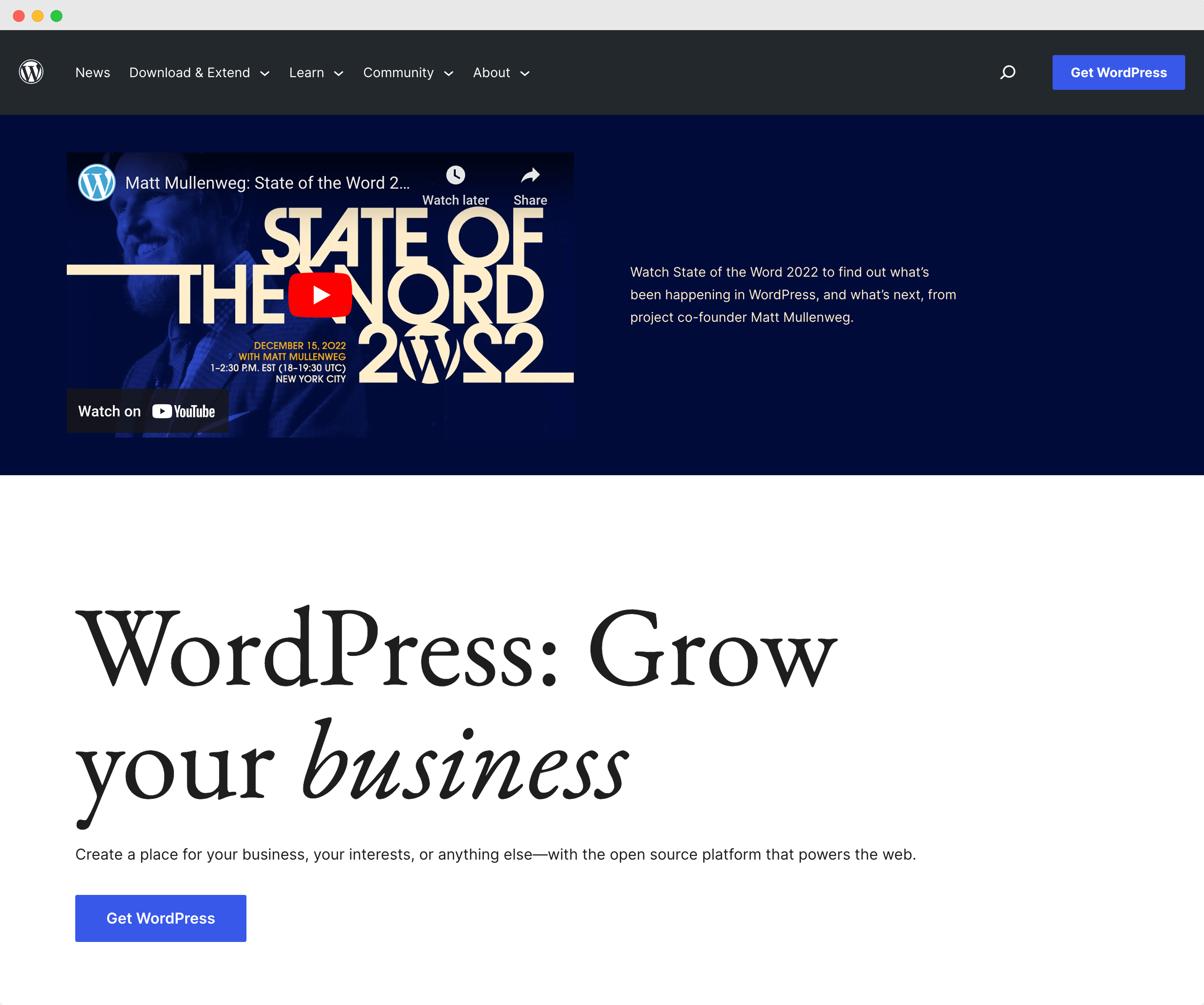
Monolithic CMSs have been around for over fifteen years, and they’ve stood the test of time. They offer a user-friendly, streamlined content editing experience and many plugins and apps that make them easy to repurpose for different use cases. Since they have a considerable market share, they also boast rich ecosystems of system integrators.
However, they also come with some limitations: these content management systems are meant for content-centric websites, not for eCommerce brands. They usually take over your entire website and don’t play nice with other parts of your tech stack. This makes them a less-than-ideal choice for a DTC brand, which needs to present the content on their storefront or even enrich it with dynamic data such as product information.
Headless CMSs
Headless CMSs were built to solve precisely these limitations. Compared to monolithic solutions, headless CMSs are much more nimble: a headless CMS only provides an interface to define your content structure and manage your content. Presenting your content is up to you, and typically requires a design and engineering team to integrate the headless CMS into your existing frontend.
Contentful has long been the primary contender in the headless CMS space, but many competitors have launched their solutions over the years: Prismic, DatoCMS, and Sanity are among the most popular alternatives, offering slightly different functionality such as custom editorial workflows/UIs and internationalization, and wildly different price points.
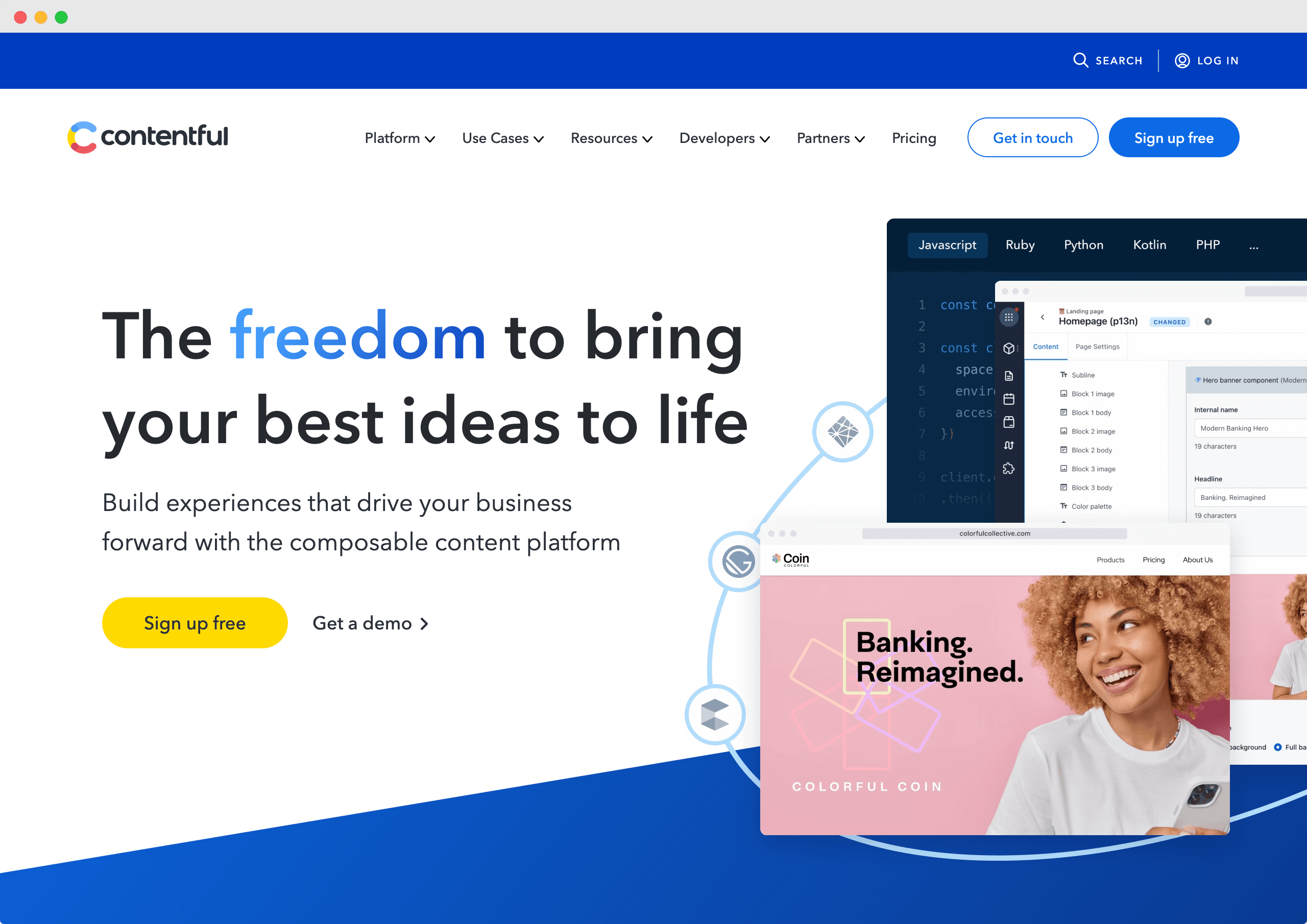
Headless CMSs enable brands to treat content as data, making it fully portable and allowing them to present their content wherever they want. Most headless CMSs also connect to your backend: for instance, an eCommerce brand will be able to pull product and pricing information from Shopify and include it right in the middle of an editorial piece. Such functionality allows you to blur the lines between content and commerce, making for a much richer customer experience.
Headless CMSs are still very popular thanks to their flexibility, but they come with their own limitations: mainly, they require design and engineering work when marketers want to integrate new types of content into a company’s existing digital properties, or whenever they want to make visual changes to the existing experience. This may be problematic for brands operating with low budgets or in high-velocity environments.
Site builders
While site builders are not technically new (Webflow was born in 2012, one year before Contentful), they’ve seen a recent surge in popularity. You can think of site builders as a modern take on monolithic CMSs: like monolithic solutions, site builders also take over your entire website. However, they offer more modern and advanced functionality, such as support for drag-and-drop editing across your entire website, responsive design, custom code, API access, and integrations with popular third-party design and development tools. Almost all site builders also include a native headless CMS, or will optionally integrate with a third-party headless CMS.
The most popular site builder is Webflow, which is often used by SaaS companies to manage their marketing websites, or by eCommerce brands to spin up self-contained editorial experiences. Webflow also allows creating gated content and building Zapier-esque workflow automation. A recent competitor is Framer, which allows designers to build, test and publish websites straight from Figma wireframes.
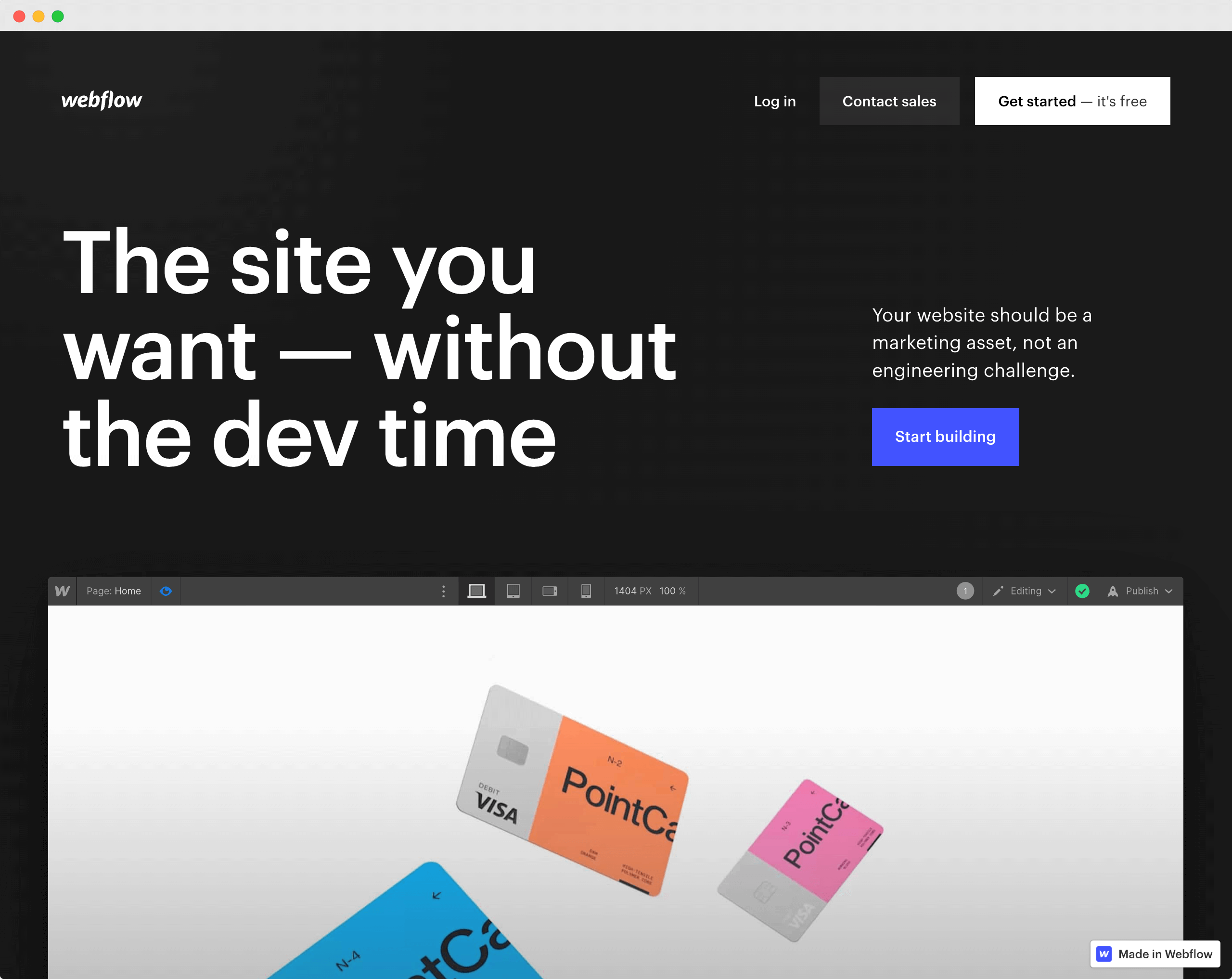
If your team has limited technical experience or you don’t want to use your engineering bandwidth, using a site builder can be an excellent way to quickly spin up new editorial experiences that will meet the standards of the modern Web. And if you need to implement deeper customizations or complicated workflows, your engineers can still make those adjustments at a reasonable pace.
The main disadvantage with site builders is that, for all their flexibility, they will still be pretty self-contained, and they’re hard to integrate with other digital properties. Maintaining brand consistency will also be more challenging since your design system will live both in your site builder and across any other frontends you have. This is fine if you’re building a standalone experience such as a microsite, but can hurt your brand reputation when used for integrated experiences such as a company blog.
Page builders
After coming full circle with site builders, the content management pendulum is swinging the other way once again with page builders. Like site builders, page builders also offer drag-and-drop editing, built-in headless CMSs, and all the modern developer tooling you might expect. Unlike page builders, site builders try to be non-obtrusive: rather than taking over your entire website, they allow you to model specific pages or sections of it. For example, you might let your eCommerce platform power your product catalog and checkout experience while your page builder powers your site navigation and blog.
The most popular page builder is Builder.io, used by several eCommerce brands such as Everlane, J.Crew, and Harry’s. It allows you to use their native visual editor or to import your own components, connects with several third-party data sources, offers built-in A/B testing, and lets you publish your content across the Web, mobile, and wherever else you want. An early-stage contender is Plasmic, which offers a very similar feature set, but pairs it with a more modern UX.
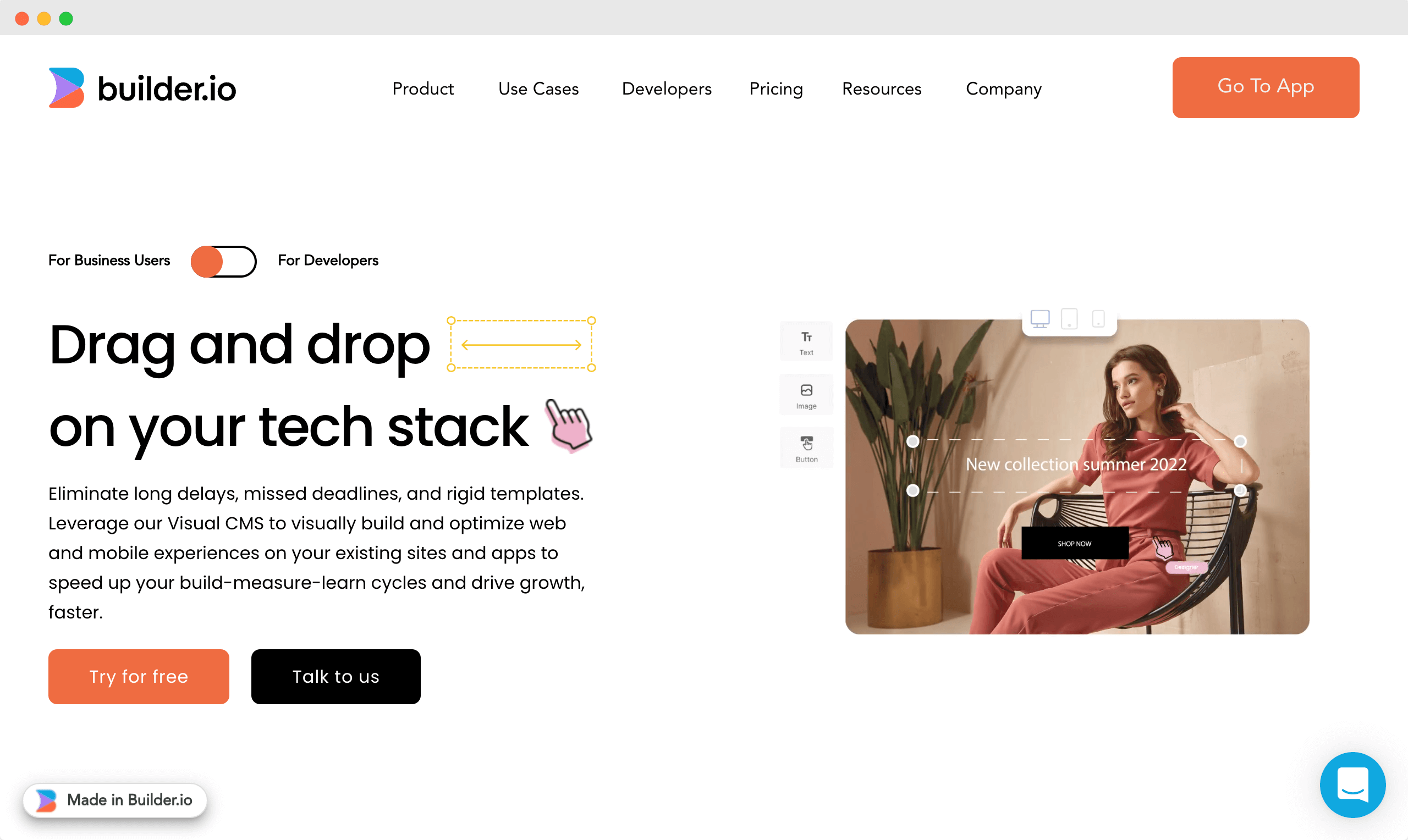
Page builders can be an excellent compromise between headless CMSs and site builders: they allow you to easily integrate your content into your existing digital properties in a non-obtrusive, brand-consistent way, and they offer a visual interface that helps non-technical stakeholders to quickly iterate on both content and presentation.
However, they are not a one-size-fits-all solution. While an essential page builder integration can be a reasonably low-effort process for your engineering team, getting page builders right can be a complex initiative. Once you start bringing in your own UI components, performing search engine optimization, running A/B tests, integrating with external data sources, or implementing rich user interactions, the level of complexity goes up dramatically, and keeping everything running smoothly can be a challenge.
Evaluating the right solution for your brand
As you’ve seen, there’s no easy answer: each eCommerce CMS has its pros and cons, which you should weigh against your company’s stage, requirements, and technical savviness. The three main factors we keep into account when picking a solution for our clients are:
-
Business goals: what do you want to achieve with your content? This is closely tied to where you’ll want to place your content, which in turn informs your choice of tooling. Are you looking to inform, inspire, or convert? (Often, it will be a mix of these, which is perfectly fine—just make sure you cover all your bases!)
-
Span of control: site builders give operators maximum flexibility to change whatever they want, whenever they want it. This is both a blessing and a curse: a non-designer making design changes can quickly become a disaster. What’s the sweet spot between not enough and too much control for your team?
-
Implementation effort: page builders are more complex to integrate than headless CMSs, which in turn are more complex to integrate than a monolithic CMS. Do the benefits outweigh the extra effort of integrating the solution with your tech stack? Apparel brand and Nebulab client Huckberry, for instance, relies heavily on their blog, The Journal. The Journal is a fully integrated part of Huckberry’s shopping experiences: articles typically feature one or more Huckberry products, which users can add to their cart with a simple click. It’s a very conversion-centric approach.

Travel brand Away, on the other hand, publishes the travel and lifestyle magazine Here. Away’s magazine has a laid-back, inspirational approach with its content, and you can hardly notice that a DTC brand is behind the project.
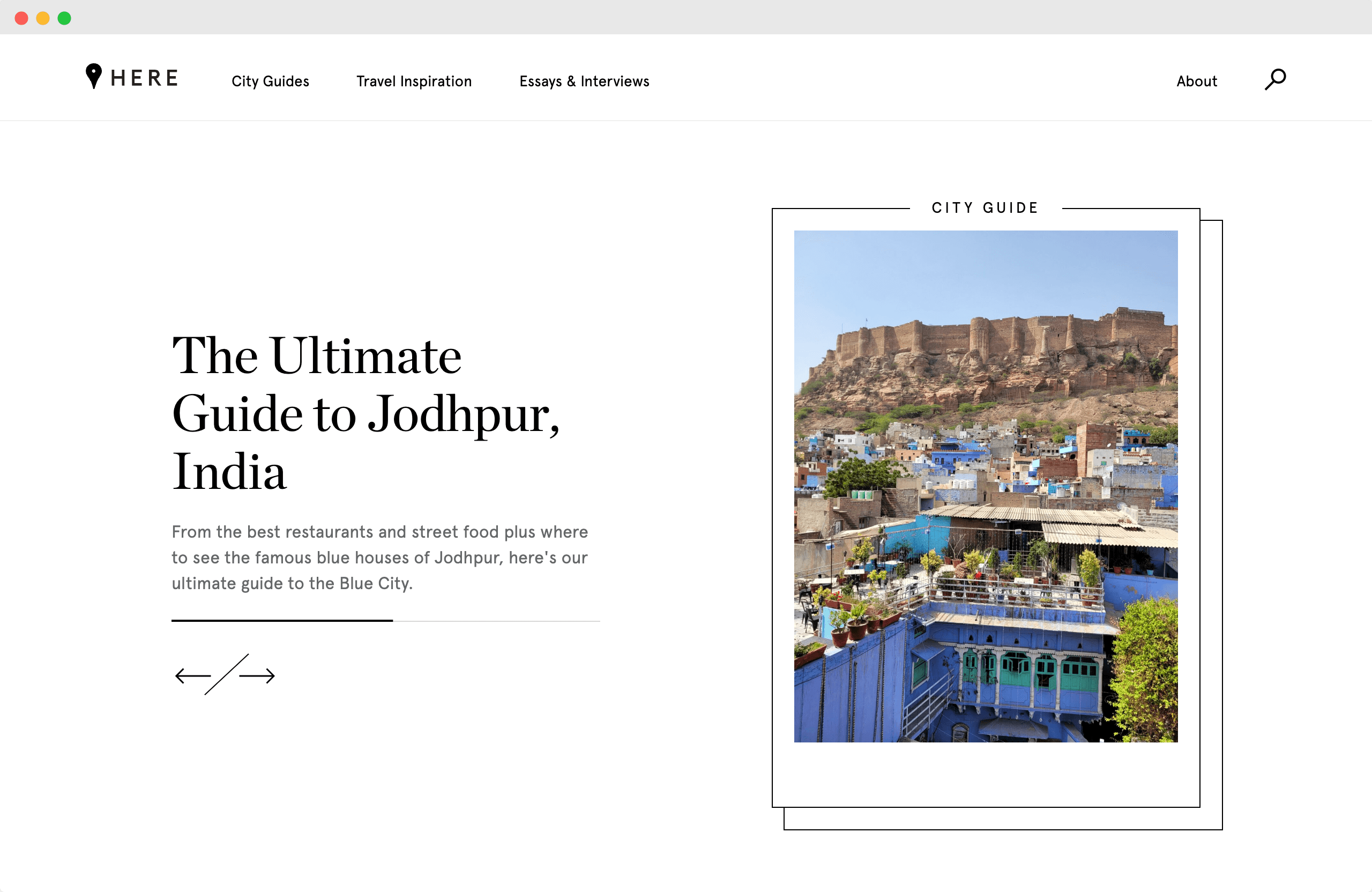
Picking tools vs. building infrastructures
Rather than only adopting one solution, we recommend creating a content management infrastructure, i.e., a suite of tools that integrate and build on top of each other. For example, here’s a typical journey a DTC brand might undergo:
-
As a first step, they adopt a headless CMS, which allows them to decouple content and presentation. They use their headless CMS as the source of truth for all their content and integrate it with their existing digital properties (e.g., their product pages).
-
At some point, the marketing team starts complaining that they can’t make visual changes to how the content is presented on their product pages without asking the engineering team. This leads the team to integrate a page builder for specific website sections (e.g., the PDP and the blog). The page builder is connected to their headless CMS, which is still used for managing the actual content.
-
The brand eventually outgrows the page builder as well: the marketing team wants to start experimenting with standalone experiences such as microsites for contests, promotions, and product launches. This is when the team adopts a site builder, giving marketing full power to launch new properties with little to no engineering assistance.
As marketing teams gain more freedom, brands need to create checks and balances to avoid brand dilution. This can mean having a content inventory that is continuously monitored for consistency, ensuring the same person is orchestrating all digital experiences, or having a full-fledged design system that can be applied across different platforms. Ultimately, how much centralization you need depends on your brand’s scale and your reliance on content.
Our favorite CMSs for eCommerce brands
At Nebulab, we have helped tens of brands design, launch and optimize their content stack, and we have developed some pretty strong opinions on which CMS platforms to use:
-
Monolithic CMS: WordPress. As mentioned, we rarely pick monolithic CMSs for eCommerce brands—but when we do, we go with WordPress. It has a beautiful, intuitive UX and an incredibly vast ecosystem of plugins and integrations, making it a good fit for many use cases and deployment options.
-
Headless CMS: Sanity. A few years ago, we would have recommended Contentful or Prismic (and we have). Ever since we’ve had a chance to try Sanity, we fell in love with its flexibility. While traditional headless CMSs force users to use a standardized UI for managing content, Sanity’s content studio is open-source and can be tailored to your content management needs and editorial workflows.
-
Page builder: Plasmic. While Builder.io has been around for slightly longer, Plasmic offers a more modern UI for their editing backend. With that said, the two tools are incredibly similar, so we encourage you to experiment with both and see which one you prefer.
-
Site builder: Webflow. Even though products like Framer offer a more streamlined experience for non-technical users, Webflow remains an incredibly powerful tool if you know how to use it. With support for custom workflows and gated content, your team can quickly spin up rich micro-sites that cover various use cases.
As always, your mileage may vary. Before committing to a solution, you should thoroughly assess your present and anticipated requirements and experiment with different setups to build a stack that can scale with you as your needs evolve. If you need any advice or want to speed up the process, we’re happy to help!



